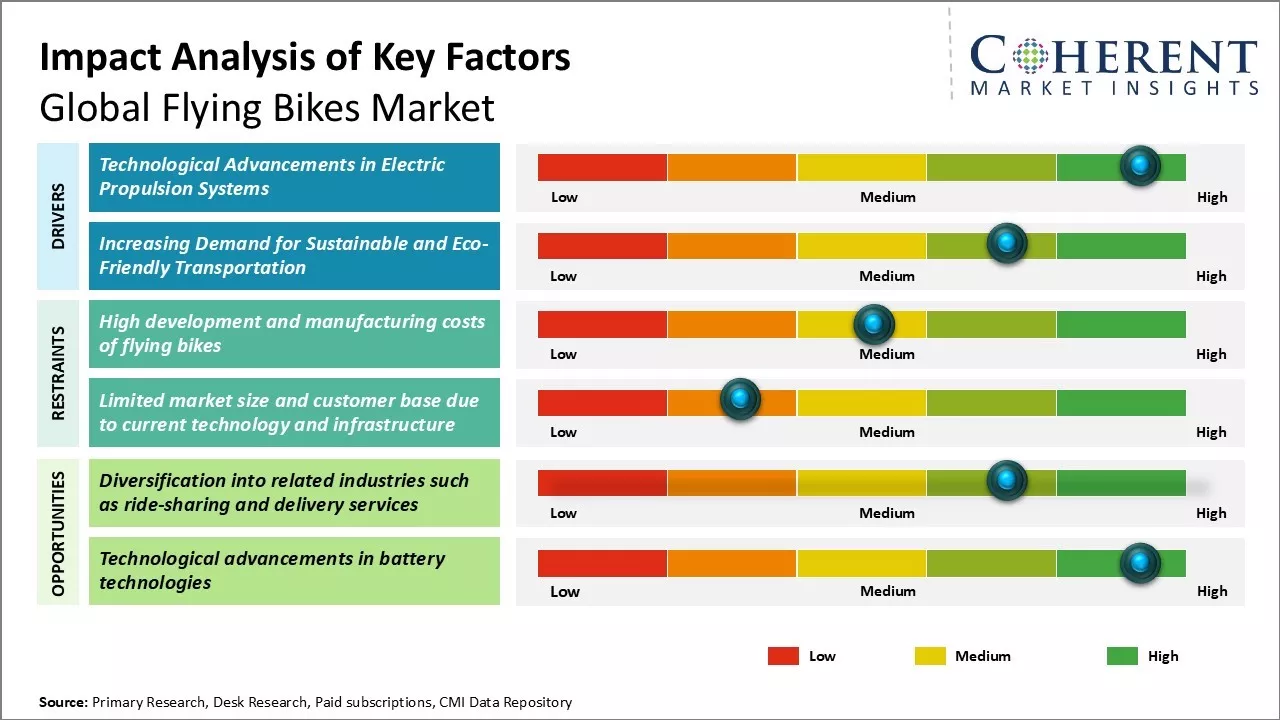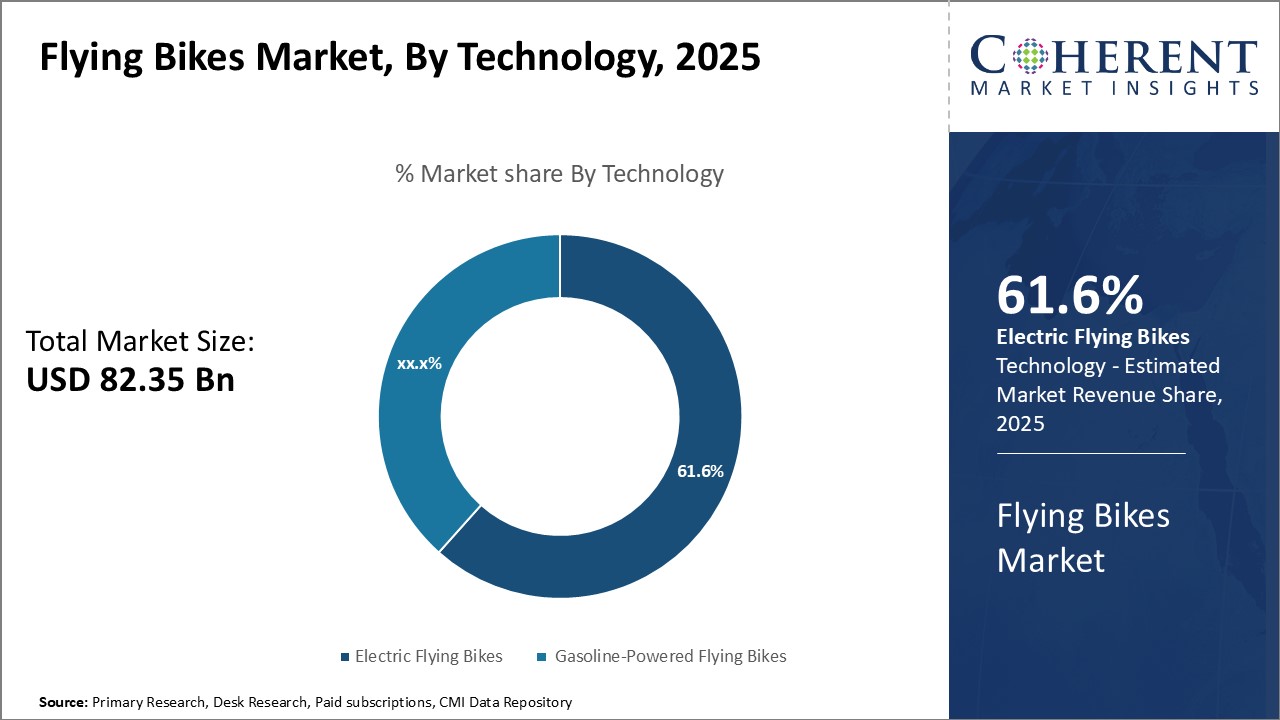The global flying bikes market is estimated to be valued at USD 82.35 Bn in 2025 and is expected to reach USD 291.80 Bn by 2032, exhibiting a compound annual growth rate (CAGR) of 19.8% from 2025 to 2032.

Discover market dynamics shaping the industry: Request sample copy
The demand for fast mobility solutions is increasing rapidly globally. Flying bikes provide a more exciting and faster mobility option compared to conventional vehicles. Growing investments in the research and development of advanced battery technologies is also supporting the development of reliable and efficient electric flying bikes. Several startups are working on prototype development and conducting test flights to commercialize flying bikes in the coming years. With continuous technological advancements, the price of flying bikes is expected to decline which can further boost their adoption. However, stringent regulations regarding their use may limit the growth of the flying bikes market to some extent.
Technological Advancements in Electric Propulsion Systems
With each passing year, engineers and researchers are finding new innovative ways to increase the efficiency and range of electric motors. Lithium-ion batteries, in particular, have seen tremendous development over the last decade which is allowing electric vehicles of all kinds to travel farther on a single charge. When it comes to flying bikes, having a powerful yet lightweight electric propulsion system is crucial to achieving sustained flight. Advancements are being made on a near constant basis to miniaturize battery packs without sacrificing energy capacity. This will allow future flying bike models to have longer flight times and be able to access more areas traditionally restricted to gasoline models.
Another area of focus is developing electric motors that are strong enough to lift a person into the air yet compact enough to fit within the frame of a bike. Researchers are experimenting with new motor designs that leverage techniques like sensorless commutation which offers smoother rotational control. Combined with advanced motor controllers, this improves efficiency and responsiveness. More electric flying bike prototypes are now demonstrating the ability to transition seamlessly between manned flight mode and conventional pedal-powered bicycle riding. As the technology matures to the point of widespread commercial availability, it will truly allow for the freedom of aerial transport to blend with traditional cycling infrastructure and roads.
The integration of artificial intelligence into electric propulsion is another promising avenue that could revolutionize flying bikes. With AI, motors could dynamically adjust power output based on real-time load calculations, altitude, and terrain factors to optimize energy usage. This would extend flying range even further. AI controllers may also facilitate autonomous flight capabilities for cargo delivery drones in future. Overall, it's clear that ongoing work on battery, motor and AI technologies will be the driving force that propels the electric flying bikes market towards mainstream adoption within the new decade.

Get actionable strategies to beat competition: Request sample copy
Increasing Demand for Sustainable and Eco-friendly Transportation
With growing environmental concerns around the world, consumers and businesses alike are actively seeking out new mobility solutions that reduce their carbon footprint. Traditional modes of transport like gasoline vehicles and even public transit in congested cities contribute significantly to air pollution. Meanwhile, distances between places continue to stretch out with expanding urbanization. This brings up the need for personal transportation methods that are not only sustainable but also help save time. Electric flying bikes have the potential to fulfill this need better than any alternative. With zero direct emissions, they offer a true green mode of travel uniquely positioned at the intersection of cycling and flight.
With their electric motors, flying bikes can travel through the sky scenery enjoying a panoramic view, while also having the option to use pedal power on routes allowing it. This dual capability as both an aerial and land vehicle makes them very flexible for a variety of everyday trips around cities and suburbs. For many commuters, flying bikes may replace the need for a second vehicle or reliance on slow public transport. They also open up entirely new direct point-to-point travel routes that can bypass traffic bottlenecks. As environmental responsibility and wellness through active transport gain wider social currency, the demand is set to surge for such innovative sustainable mobility solutions in the form of electric flying bikes. Manufacturers are keen to tap into this multiplying consumer base seeking eco-friendly personal air vehicles.
Key Takeaways from Analyst:
The global flying bikes market has strong growth potential over the next decade. Major technological advancements in electric propulsion systems and lightweight yet durable materials will drive the adoption of these innovative mobility solutions. Ongoing improvements in battery energy density allow for longer flight durations per charge. As flight times increase to 30 minutes or more, flying bikes will become a practical mode of transportation for many short-distance trips. Declining battery prices will also make flying bikes more affordable to mainstream consumers.
North America currently lead in flying bike development efforts and have the most progressive regulations supporting commercial use. However, Asia Pacific is anticipated to see the fastest early adoption given large urban populations and public enthusiasm for new mobility technologies. Growing traffic congestion and lack of transportation infrastructure in many Asian cities make flying bikes an attractive alternative to driving or public transit.
Safety concerns remain the biggest challenge facing broader commercialization. Strict certification standards will need to be established and manufacturers must focus keenly on crashworthiness. Public acceptance will depend greatly on a demonstrated strong safety record over time. The relative youth of the concept also raises insurance costs that could limit early accessibility. Off-peak demand may also prove lower than hoped once novelty wears off.
Market Challenge - High development and manufacturing costs of flying bikes
The high costs associated with the development and manufacturing of flying bikes poses a significant challenge for the growth of the global market. Designing and building prototypes that can carry people safely through the air requires extensive research and testing. Aerospace-grade materials and precision engineering that meet various aviation regulations across countries also add to the expenses. Mass production would help lower unit costs through economies of scale, but achieving the necessary sales volumes to reach that scale remains an uphill task given the premium prices. Unless production costs plateau at an affordable level for the average consumer, the market is likely to remain a niche for wealthy early adopters only. Existing players will need to find innovative ways to standardize designs, source less expensive components, and improve production efficiencies to make flying bikes financially viable for the masses.
Market Opportunity - Diversification into related industries such as ride-sharing and delivery services
The global flying bikes market presents immense opportunities for diversification into related sectors that can help scale operations and maximize returns. Companies involved can leverage their expertise in manufacturing and maintaining flying vehicles to venture into lucrative ride-sharing services. By enabling convenient point-to-point air travel for short intra-city commutes and last-mile connectivity, they can tap into the growing demand for quicker transportation alternatives in congested urban centers. There is also scope for diversifying into delivery services for time-critical shipments of medicines, packages and food items. This can help generate additional revenue streams, offset manufacturing costs to some extent and position flying bikes as a practical mode of transport beyond just personal usage. Successfully diversifying into complementary industries can accelerate flying bike adoption and boost the overall market potential in the long run.

Discover high revenue pocket segments and roadmap to it: Request sample copy
Insights By Technology - Rising Environmental Concerns Accelerate the Demand for Electric Flying Bikes
In terms of technology, electric flying bikes is expected to contribute the 61.6% share of the market in 2025 owing to growing environmental concerns. Electric flying bikes provide a zero-emission mode of transportation, which has increased their desirability among both commercial and recreational users. The operational costs of electric flying bikes are also much lower as they do not require expensive gasoline. Additionally, advancements in battery technology have significantly improved the range of electric flying bikes in recent years. Lithium-ion batteries now allow electric flying bikes to travel distances comparable to gasoline-powered models. Regulatory push for greener transportation solutions has further encouraged adoption of electric flying bikes across various regions. Major governments offer subsidies and tax rebates to consumers opting for electric flying bikes over traditional gasoline variants. With sustainability becoming a top priority, the demand for environment-friendly electric flying bikes is expected to rise substantially in the coming years.
Insights By Range - Rising Popularity of Short-range Recreational Activities
In terms of range, short-range (up to 20 miles) contributes the 43% share of the market in 2025. Short-range flying bikes have gained immense popularity among recreational riders as they provide an ideal means for short leisurely trips. Their compact size and relatively lower costs have boosted the popularity of short-range models in retail. Furthermore, restrictions on flying distances within city limits have limited viable options to short-range variants for personal use. Short hops of under 20 miles cover a major part of daily commutes as well as weekend rides undertaken by recreational riders. Limited flying skills of new entrants have also increased focus on user-friendly short-range flying bikes. The convenience and affordability of short-range models have made them the primary choice for a rising number of recreational pilots worldwide.
Insights By Application - Widespread Civilian and Military Applications
In terms of application, personal/recreational use contributes the 57.8% share of the market in 2025. However, Commercial Use (Tourism, Emergency Services, etc.), and Military and Defense presents sizable opportunities for flying bike manufacturers. Commercial applications including tourism are gaining prominence as flying bikes improve long-range efficiency. Their maneuverability makes flying bikes an effective choice for search and rescue operations. Several military and paramilitary forces additionally employ flying bikes for border patrolling, mobility, and transportation needs due to their versatility. Government contracts provide a reliable revenue stream for defense-oriented flying bike variants. Although personal use currently leads, the diverse commercial, military, and industrial applications indicate strong future demand across various sectors.

Need a Different Region or Segment? Customize now
North America Dominance in Flying Bikes Market
North America has emerged as the global leader in the flying bikes market, primarily led by the U.S. The region is expected to account for over 35.5% of the market share due to strong industrial presence and technological advancements in the region. Aviation has seen rapid innovation in the U.S., with major flying bike manufacturers basing their operations in the country. Additionally, the presence of prominent research institutions has supported the development of new designs and technologies. Several pilot projects and partnerships between top automobile and aviation companies have been announced in recent years, aiming to launch commercial flying bikes in the coming decade. This robust R&D ecosystem comparable to none has enabled North American companies to introduce industry-first features and designs.
Asia Pacific as the Fastest Growing Region
The Asia Pacific region has shown tremendous growth potential and is emerging as the fastest growing market for flying bikes globally. Countries like China and India offer a massive consumer base as well as a conducive manufacturing environment due to low production costs. Several Chinese automotive giants have announced plans to enter the flying bike segment to tap growing domestic demand. India too has witnessed increased focus on the development of urban air mobility solutions including flying bikes to address issues of traffic congestion in its major cities. Both Indian and Chinese governments are actively promoting initiatives like these through policy support and investments. Increased industrial activities across sectors have augured well for the supply chain of flying bike industry expansion in Asia Pacific. The region is well positioned to surpass North America in terms of total market size in the coming decade.
Flying Bikes Market Report Coverage
| Report Coverage | Details | ||
|---|---|---|---|
| Base Year: | 2024 | Market Size in 2025: | USD 82.35 Bn |
| Historical Data for: | 2020 To 2024 | Forecast Period: | 2025 To 2032 |
| Forecast Period 2025 to 2032 CAGR: | 19.8% | 2032 Value Projection: | USD 291.80 Bn |
| Geographies covered: |
|
||
| Segments covered: |
|
||
| Companies covered: |
AeroMobil, Aston Martin, Carplane, Clip Air, EHang, Jetpack Aviation, Klein Vision, Lilium, PAL-V, Urban Aeronautics, Vahana (Airbus), Vertical Aerospace, Wright Electric, Xpeng, and Zapata Racing |
||
| Growth Drivers: |
|
||
| Restraints & Challenges: |
|
||
Uncover macros and micros vetted on 75+ parameters: Get instant access to report
*Definition: The global flying bikes market consists of electric vertical take-off and landing (eVTOL) vehicles that are capable of both road and aerial transportation. These lightweight flying bikes allow users to quickly escape ground traffic congestion and soar over obstacles. They are powered by rechargeable batteries and equipped with rotors or small wing surfaces for vertical lift and forward flight. The global flying bikes market is expected to grow significantly in the coming years as the development of flying personal mobility solutions increases, providing an innovative new way to commute and travel.
Share
Share
About Author
Gautam Mahajan is a Research Consultant with 5+ years of experience in market research and consulting. He excels in analyzing market engineering, market trends, competitive landscapes, and technological developments. He specializes in both primary and secondary research, as well as strategic consulting across diverse sectors.
Missing comfort of reading report in your local language? Find your preferred language :
Transform your Strategy with Exclusive Trending Reports :
Frequently Asked Questions
Joining thousands of companies around the world committed to making the Excellent Business Solutions.
View All Our Clients
US Reciprocal Tax Impact Analysis On Flying Bikes Market
Stay updated on tariff changes with expert insights and timely information